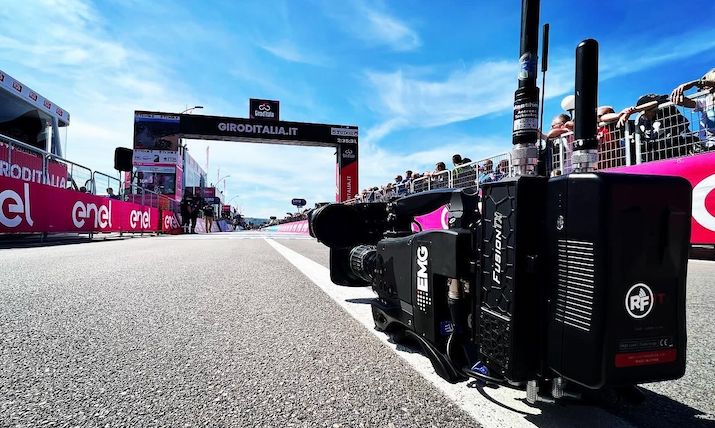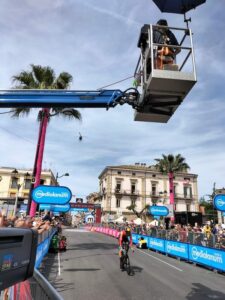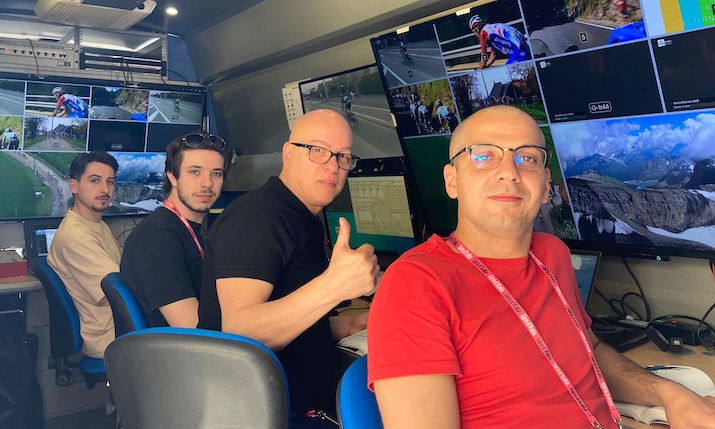Boost Graphics partners with RCS for timing, live graphics and data processing of the Giro d’Italia 2023

Boost Graphics, the specialised graphics department of EMG, has been on site as a service provider for 21 editions of the Giro d’Italia. For this event, which started on 6 May and finishes on 28 May, Boost is the supplier of all graphics and timing in collaboration with partner Microplus.
Antonello Grippo, project leader of graphics services at Boost, explains: “There are two dedicated live graphics lines, one for the domestic signal and one for the international for the many hours of live race coverage. Thanks to the data processing work in the live graphics, we have implemented numerous innovations to offer the user more information and content.”
For timekeeping two photo finish systems are used at the finish line and a transponder is installed on each bike. This allows a double level of control to determine the order of arrival. In addition, for some stages an antenna is placed at least 3km from the finish so the times won’t be affected if there are crashes in the group in the last stretch.
“This is valid,” adds Grippo, “on all stages, except the mountain ones. For all the stages, however, there are intermediate surveys for the points classification which assigns the maglia ciclamino [the mauve jersey of the top points scorer] and bonuses for the general classification.”
Motorcycles and GPS
During the race, GPS signals transmitted by the motorbikes filming the athletes along the route are also used. By processing this data, Boost is able to provide real-time data throughout the live broadcast, including the distance to the finish line and the gaps between groups.
This is also possible thanks to Velon, another RCS partner, which captures advanced live data to enrich the editorial product.

The devices mounted on the bikes capture key data for each athlete, such as power, cadence, speed, heart rate and gradient on uphill stretches. In addition to live graphics, this data is also made available for post-production to create clips of the cyclists in the competition.
Grippo explains: “Thanks to all of this data we are able to know the position in real-time of the maglia rosa [the pink jersey worn by the leader of the overall classification], of the second rider in the standings, as well as of all the athletes in the race. Furthermore, thanks to our experience in data processing, calculations and aggregations are carried out to develop further algorithms. This allows us to offer additional information and content, both for live graphics and digital outputs.”
All the software used to deliver this information is developed and owned by EMG-Boost Graphics.
Boost has a team of around 15 people dedicated to graphics, timing and data processing services, rising to nearer 20 during the timed stages. A large part of the crew is placed at the finish line, while others preside over the intermediate sprints during the stages that contribute to the points classification.
There are also five mobile vehicles on site, three at the finish line and two at the intermediate stages.

The Boost team on site in one of five OBs
Dario Marra, head of graphics at Boost, said: “Following the request of organiser RCS, Boost Graphics has introduced various small editorial innovations for this year’s edition of the Giro that have not gone unnoticed.
“This additional information, as well as the novelties related to the look and feel, will ensure the public enjoy an even more engaging product.
“RCS has elected us to deliver live graphics, timing and data processing services for this competition for the next two years. Looking ahead, the goal is to introduce further innovations both in terms of look and content, thanks to our strong drive in terms of innovation and the international expertise of the EMG Group.”

